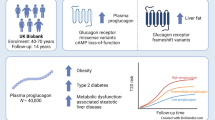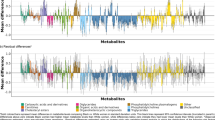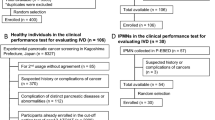Abstract
There are no consensus guidelines or standards for epidemiologic and ‘-omics’ studies using blood biomarkers on how to report the timing of extraction of blood samples. However, disease-induced changes in blood concentrations of exogenous and endogenous compounds may bias studies. The aim of the present report is to describe the timing of blood collection with respect to a variety of relevant clinical events in the PANKRAS II Study, and to suggest ways to display graphically the quantitative information. Subjects were 167 incident cases of exocrine pancreatic cancer prospectively recruited in five teaching hospitals in eastern Spain. Over 80% of patients had blood extracted during the first 6 months since onset of cancer symptoms, and 82% within the first month of admission to a study hospital. Over 80% of cases had blood drawn after an ultrasound, a CT scan or an ERCP, 25% after a laparotomy, and 37% after treatment onset. All three intervals from blood extraction to diagnosis, to treatment onset and to interview had a median of 0 days, and 88% of cases had blood drawn within 2 weeks of diagnosis. Over 72% of cases had concentrations of total lipids in the medium, normal range. Results suggest ways to report intervals involving blood biomarkers and may contribute to develop consensus guidelines and standards on the collection of blood samples in epidemiologic and ‘-omics’ research.



Similar content being viewed by others
Abbreviations
- PANKRAS II:
-
Multicentre prospective study on the role of K-ras and other genetic alterations in the diagnosis, prognosis and etiology of pancreatic and biliary diseases
- EPC:
-
Exocrine pancreatic cancer
- CI:
-
Confidence interval
- SD:
-
Standard deviation
- CT:
-
Computerized axial tomography
- ERCP:
-
Endoscopic retrograde colangiopancreatography
- TPCH:
-
Transparietohepatic cholangiography
- TNM:
-
Tumour-node-metastasis system
References
Schulte PA, Perera F, editors. Molecular epidemiology. Principles and practice. Orlando, Florida: Academia Press; 1993.
Carrington M, Hoelzel R. Molecular epidemiology. New York: Oxford University Press; 2001.
Toniolo P, Boffetta P, Shuker DEG, Rothman N, Hulka B, Pearce N, editors. Application of biomarkers in cancer epidemiology. IARC Scientific publications, no 142. Lyon: International Agency for Research on Cancer; 1997.
Porta M. Role of organochlorine compounds in the etiology of pancreatic cancer: a proposal to develop methodological standards. Epidemiology 2001;12:272–6.
Hoppin JA, Tolbert PE, Taylor JA, Schroeder JC, Holly EA. Potential for selection bias with tumor tissue retrieval in molecular epidemiology studies. Ann Epidemiol. 2002;12:1–6.
Porta M, Malats N, Corominas JM, Rifa J, Pinol JL, Real FX, for the Pankras I Project Investigators. Generalizing molecular results arising from incomplete biological samples: expected bias and unexpected findings. Ann Epidemiol 2002;12:7–14.
Hoppin JA, Tolbert PE, Holly EA, et al. Pancreatic cancer and serum organochlorine levels. Cancer Epidemiol Biomark Prev 2000;9:199–205.
Porta M, Ferrer-Armengou O, Pumarega J, López T, Crous-Bou M, Alguacil A, et al. In a clinical and molecular epidemiologic study on exocrine pancreatic cancer clinical factors were related to timing of blood extraction and influenced serum concentrations of lipids. J Clin Epidemiol 2008;61 (in press).
Rønningen KS, Paltiel L, Meltzer HM, Nordhagen R, Lie KK, Hovengen R, et al. The biobank of the Norwegian mother and child cohort Study: a resource for the next 100 years. Eur J Epidemiol 2006;21:619–25.
Porta M, Hernández-Aguado I, Lumbreras B, Crous-Bou M. ‘Omics’ research, monetization of intellectual property and fragmentation of knowledge: can clinical epidemiology strengthen integrative research?. J Clin Epidemiol 2007;60 (in press).
Porta M, Malats N, Jariod M, Grimalt JO, Rifà J, Carrato A, et al. Serum concentrations of organochlorine compounds and K-ras mutations in exocrine pancreatic cancer. Lancet 1999;354:2125–9.
Porta M, Malats N, Guarner L, Carrato A, Rifà J, Salas A, et al. Association between coffee drinking and K-ras mutations in exocrine pancreatic cancer. J Epidemiol Community Health 1999;53:702–9.
Soler M, Malats N, Porta M, Fernandez E, Guarner L, Maguire A, et al. Medical conditions in patients with pancreatic and biliary diseases: validity and agreement between data from questionnaires and medical records. Dig Dis Sci 1999;44:2469–77.
Soler M, Porta M, Malats N, Guarner L, Costafreda S, Gubern JM, et al. Learning from case reports: Diagnostic issues in an epidemiologic study of pancreatic cancer. J Clin Epidemiol 1998;51:1215–21.
Gavaldà L, Porta M, Malats N, Piñol JL, Fernandez E, Maguire A, et al. Agreement between information supplied by the patient and a family member on medical history, consumption of tobacco, alcohol and coffee and diet in cancer of the exocrine pancreas and extrahepatic biliary tract. Gac Sanit 1995;9:334–42.
Porta M, Costafreda S, Malats N, Guarner L, Soler M, Gubern JM, et al. Validity of the hospital discharge diagnosis in epidemiologic studies of biliopancreatic pathology. Eur J Epidemiol 2000;16:533–41.
Porta M, Jariod M, Malats N, Grimalt JO, Carrato A, Guarner L, et al. Prevalence of K-ras mutations at diagnosis and serum levels of DDT, DDE, PCBs and other organochlorine compounds in exocrine pancreatic cancer. In: Gress TM, editor. Molecular pathogenesis of pancreatic cancer. Amsterdam: IOS Press; 2000. p. 37–44.
Porta M, Malats N, Alguacil J, Ruiz L, Jariod M, Carrato A, et al. Coffee, pancreatic cancer, and K-ras mutations: updating the research agenda. J Epidemiol Community Health 2000;54:656–9.
Alguacil J, Kauppinen T, Porta M, Partanen T, Malats N, Kogevinas M, et al. Risk of pancreatic cancer and occupational exposures in Spain. Ann Occupat Hyg. 2000;44:391–403.
Alguacil J, Porta M, Benavides FG, Malats N, Kogevinas M, Fernàndez E, et al. Occupation and pancreatic cancer in Spain: a case–control study based on job titles. Int J Epidemiol 2000;29:1004–13.
Malats N, Casals T, Porta M, Guarner L, Estivill X, Real FX for the PANKRAS II Study Group. The cystic fibrosis transmembrane regulator (CFTR) DF508 mutation and 5T allele in patients with chronic pancreatitis and exocrine pancreas cancer. Gut 2001;48:70–4.
Real FX, Malats N, Lesca G, Porta M, Chopin S, Lenoir GM, et al. Family history of cancer and germline BRCA2 mutations in sporadic exocrine pancreas cancer. Gut 2002;50:653–7.
Porta M, Zumeta E, Ruiz L, Jariod M, Malats N, Marco E, et al. The influence of age and gender on serum concentrations of p,p′-DDT, p,p′-DDE and the DDT/DDE ratio in subjects with exocrine pancretic cancer. Organohalogen Compounds 2002;59:351–4.
Porta M, Ruiz L, Jariod M, Zumeta E, Malats N, Marco E, et al. Correlations among serum concentrations of highly prevalent organochlorine compounds in patients with exocrine pancreatic cancer. Organohalogen Compounds 2002;55:307–10.
Alguacil J, Porta M, Malats N, Kauppinen T, Kogevinas M, Benavides FG, et al. Occupational exposure to organic solvents and K-ras mutations in exocrine pancreatic cancer. Carcinogenesis 2002;23:101–6.
Alguacil J, Porta M, Kauppinen T, Malats N, Kogevinas M, Carrato A. Occupational exposure to dyes, metals, polycyclic aromatic hydrocarbons and other agents and K-ras activation in human exocrine pancreatic cancer. Int J Cancer 2003;107:635–41.
Porta M, Fabregat X, Malats N, Guarner L, Carrato A, de Miguel A, et al. Exocrine pancreatic cancer: symptoms at presentation and their relation to tumour site and stage. Clin Transl Oncol. 2005;7:189–97.
Mendez MA, Vioque J, Porta M, Morales E, López T, Malats N, et al. Estimating dietary intakes from a brief questionnaire: a simulation study of reliability in a molecular epidemiologic study of pancreatic and biliary diseases. Eur J Epidemiol 2006;21:417–26.
Morales E, Porta M, Vioque J, López T, Mendez MA, Pumarega JA, et al. Food and nutrient intakes and K-ras mutations in exocrine pancreatic cancer. J Epidemiol Community Health 2007;61 (in press).
Porta M, Grimalt JO, Jariod M, Ruiz L, Marco E, López T, et al. The influence of lipid and lifestyle factors upon correlations between highly prevalent organochlorine compounds in patients with exocrine pancreatic cancer. Environ Int 2007;33 (in press).
Crous-Bou M, De Vivo I, Porta M, Pumarega JA, López T, Alguacil J, et al. CYP1B1 polymorphisms and K-ras mutations in patients with pancreatic ductal adenocarcinoma. Dig Dis Sci 2007;52 (in press).
Crous-Bou M, Porta M, López T, Jariod M, Malats N, Alguacil J, et al. Lifetime history of tobacco consumption and K-ras mutations in exocrine pancreatic cancer. Pancreas 2007;34 (in press).
International Union Against Cancer. TNM classification of malignant tumours. 4th ed. 2nd revision. Berlin: Springer, 1992.
Fernandez E, Porta M, Malats N, Belloc J, Gallén M. Symptom to diagnosis interval and survival in cancers of the digestive tract. Dig Dis Sci 2002;47:2434–40.
Porta M, Fernandez E, Belloc J, Malats N, Gallén M, Alonso J. Emergency admission for cancer: a matter of survival?. Br J Cancer 1998;77:477–84.
Porta M, Gallén M, Belloc J, Malats N. Predictors of the interval between onset of symptoms and first medical visit in patients with digestive tract cancer. Int J Oncol 1996;8:941–9.
Gómez G, Porta M, Griful E, Maguire A, Calle ML, Malats N, et al. Modelling breast cancer survival and the symptom-to-treatment interval. J Epidemiol Biostat 1996;1:175–82.
Maguire A, Porta M, Malats N, Gallén M, Piñol JL, Fernandez E for the ISDS II Project Investigators. Cancer survival and the duration of symptoms. An analysis of possible forms of the risk function. Eur J Cancer 1994;30A:785–92.
Porta M, Gallén M, Malats N, Planas J. The influence of “diagnostic delay” upon cancer survival. An analysis of five tumour sites. J Epidemiol Community Health 1991;45:225–30.
Malats N, Belloc J, Gallén M, Porta M. Disagreement between hospital medical records and a structured patient interview on the type and date of the first symptom in cancers of the digestive tract. Rev Épidémiol Santé Publique 1995;43:533–40.
Porta M, Malats N, Belloc J, Gallén M, Fernandez E. Do we believe what patients say about their neoplastic symptoms? An analysis of factors that influence the interviewer’s judgement. Eur J Epidemiol 1996;12:553–62.
Porta M, Fernandez E, Alguacil J. Semiology, proteomics and the early detection of symptomatic cancer. J Clin Epidemiol 2003;56:815–9.
Phillips DL, Pirkle JL, Burse VW, et al. Chlorinated hydrocarbon levels in human serum: effects of fasting and feeding. Arch Environ Contam Toxicol 1989;18:495–500.
Armitage P, Berry G, Matthews JNS. Statistical methods in medical research. 4th ed. Oxford: Blackwell; 2002.
Gammon MD, Wolff MS, Neugut AI, et al. Treatment for breast cancer and blood levels of chlorinated hydrocarbons. Cancer Epidemiol Biomarkers Prev 1996;5:467–71.
Ward EM, Schulte P, Grajewski B, et al. Serum organochlorine levels and breast cancer: a nested case–control study of Norwegian women. Cancer Epidemiol Biomarkers Prev 2000;9:1357–67.
Millikan R, DeVoto E, Duell EJ, et al. Dichlorodiphenyldichloroethene, polychlorinated biphenyls, and breast cancer among African-American and white women in North Carolina. Cancer Epidemiol Biomarkers Prev 2000;9:1233–40.
Jurek AM, Maldonado G, Greenland S, Church TR. Exposure-measurement error is frequently ignored when interpreting epidemiologic study results. Eur J Epidemiol 2006;21:871–6.
Ekman A, Dickman PW, Klint Å, Weiderpass E, Litton JE. Feasibility of using web-based questionnaires in large population-based epidemiological studies. Eur J Epidemiol 2006;21:103–11.
Lumbreras B, Porta M, Hernández-Aguado I. Assessing the social meaning, value and implications of research in genomics [Editorial]. J Epidemiol Community Health 2007; 61 (in press).
Acknowledgements
This work was supported by research grants from Generalitat de Catalunya (CIRIT SGR 0241, SGR 0078); ‘Red temática de investigación cooperativa de centros en Cáncer’ (C03/10), ‘Red temática de investigación cooperativa de centros en Epidemiología y salud pública’ (C03/09); CIBER de Epidemiologíay Salud Publica (CIBERESP), Instituto de Salud Carlos III. The authors gratefully acknowledge scientific advice provided by Elisa Puigdomènech, Marta Crous-Bou, Ángel Vicente, Luisa Guarner, Francisco X. Real, Juli Rifà, Alfredo Carrato and Josep M. Corominas, as well as technical assistance from David J. MacFarlane, Isabel Egea and Silvia Geeraerd.
Author information
Authors and Affiliations
Consortia
Corresponding author
Additional information
PANKRAS II Study Group—Members of the Multicentre Prospective Study on the Role of K-ras and other Genetic Alterations in the Diagnosis, Prognosis and Etiology of Pancreatic and Biliary Diseases (PANKRAS II) Study Group are mentioned in previous publications.
An erratum to this article can be found at http://dx.doi.org/10.1007/s10654-007-9192-4
Rights and permissions
About this article
Cite this article
Porta, M., Pumarega, J., Ferrer-Armengou, O. et al. Timing of blood extraction in epidemiologic and proteomic studies: results and proposals from the PANKRAS II Study. Eur J Epidemiol 22, 577–588 (2007). https://doi.org/10.1007/s10654-007-9149-7
Received:
Accepted:
Published:
Issue Date:
DOI: https://doi.org/10.1007/s10654-007-9149-7




